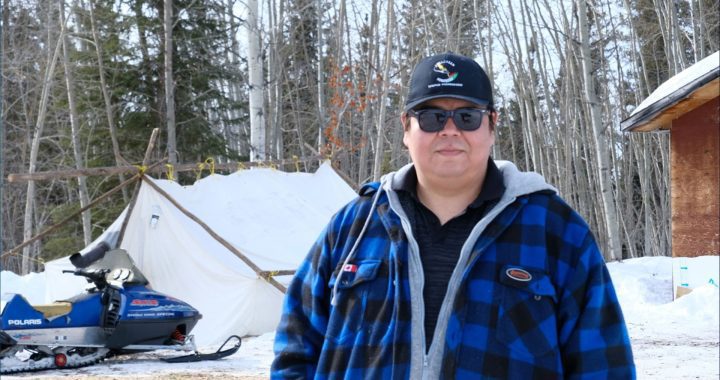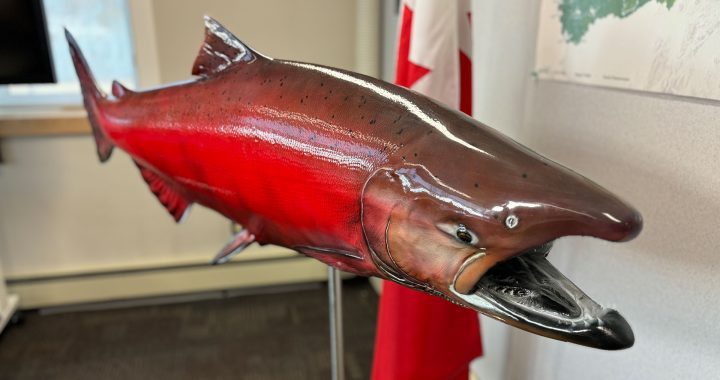Haida company facing controversy over Pacific Ocean iron dust dump says it's "creating life"
The head of a Haida-owned company at the centre of an environmental controversy after its fishing boat dumped 100 tonnes of iron sulphite to seed the Pacific Ocean says the experiment is not a potential ecological disaster, but one that has “created life.”
By Jorge Barrera
APTN National News
The head of a Haida-owned company at the centre of an environmental controversy after its fishing boat dumped 100 tonnes of iron sulphite to seed the Pacific Ocean says the experiment is not a potential ecological disaster, but one that has “created life.”
The Haida Salmon Restoration Corporation launched the $2.5 million experiment to boost the level of available plankton for salmon and create a carbon sink to tap into the potentially lucrative carbon credit market. The experiment was carried out under the direction of Russ George, a maverick businessman who has been hounded by environmentalists for years.
The experiment, the largest geoengineering project in the world, was carried out in July more than 320 kilometres west of the Haida Gwaii islands off British Columbia’s coast. It has been roundly criticized by some environmental groups who say it violates at least two UN moratoria and that it plays a dangerous game trying to artificially alter ecosystems.
John Disney, head of the Haida Salmon Restoration Corporation and economic development officer for the Old Massett Village, said the experiment is simply recreating natural conditions to boost the survival rates for Pacific salmon which form one of the cornerstones of Haida diet and culture.
“We just created a big area of life where there wasn’t life,” said Disney. “It wasn’t done half-hazardly. It was done scientifically and we have many, many systems monitoring.”
Disney also dismissed charges the experiment violated UN resolutions on ocean dumping. He said “three sets of lawyers” have reviewed the project and found it didn’t go against any UN positions.
Disney has also met several times with Environment Canada officials who have known about the project for several months. Because the experiment took place in international waters, there is little Environment Canada can do about it.
“We have lawyers watching our back,” he said. “I kept (Environment Canada) in the loop on this.”
Environment Canada issued a statement stating that it was investigating the issue. The department, however, did not respond to questions about how long it knew about the experiment.
Disney also said the depiction of George, who is the “chief scientist” for the experiment, has been misleading.
“He is amazing at taking a scientific theory and applying to the bush or the ocean and adjusting it adapting it so it really works in the real world,” said Disney. “These (type of) guys are geniuses and they are frowned upon on the academic world.”
Described as a controversial businessman, George once ran a geoengineering company called Planktos Corp. which previously failed to execute similar projects in other parts of the world, including the Canary Islands.
“Planktos proposes that its iron fertilization project will trigger oceanic phytoplankton blooms that will absorb atmospheric carbon dioxide through photosynthesis,” states the letter. “Prominent international scientific bodies with expertise in ocean dumping, ocean health and climate change…have questioned the scientific underpinnings of projects like Planktos’ and expressed grave concern.”
The letter was signed by Greenpeace, Friends of the Earth, ETC Group and Fishwise, among others.
APTN National News could not reach George for comment. However, George defended himself against attacks from environmentalists in an Op-Ed piece published in the Ottawa Citizen in 2007.
“Perhaps it is a kind of fundamentalism that drives this, where all for-profit companies are intrinsically evil,” said George, whose company was based in California. “Perhaps they fear that if the patient, in this case Mother Earth, is somehow brought back from the edge of death, their raison d’etre will disappear.”
Disney said he has known George since 2003 and the two have worked on projects over the years, including a study on shaving down the time it takes to reforest logged-out old growth forests by 150 years. Disney said he’s upset with the portrayal of his community as being duped by George.
“Has he ever lied to us? Is he a ruthless American businessman? No he isn’t,” said Disney. “We wanted him for his marine science knowledge.”
Disney said the 750 residents of Old Massett Village were extensively consulted and they voted in March 2011 66 per cent in favour of allowing council to finance the $2.5 million project.
He hopes the project will eventually turn a profit on the carbon credit market because plankton consume carbon dioxide.
Disney said plankton levels have been dropping for years and it has had a severe impact on salmon population which depends on it as a main source of food. As a result, young salmon can’t bulk up quick enough in the ocean to avoid natural predators, he said.
Disney said the plankton have been starving to death as a result of dropping iron levels in the ocean triggered by climate change.
The experiment took pulverized dirt dug up from a high-iron zone in Alberta and dumped it into an eddy far off Haida Gwaii’s coasts.
The iron dust dump has created a 10,000 square kilometre plankton bloom that has been captured by satellite.
“We haven’t found one negative side affect,” said Disney. “I talked to every single scientist involved in this…and they said…it was 100 per cent positive.”
Using an array of high-tech equipment, Disney said the experiment is under constant monitoring.
Disney said he believes the surprise 2010 sockeye salmon run which saw 40 million of the fish return to the Fraser River was primarily caused by an increase of iron in the ocean caused by the eruption of a volcano in 2008 that spread ash over the North Pacific.
Environmental organizations, in particular Ottawa-headquartered ETC Group, have been critical of the experiment.
“We have been watching ocean fertilization and geoengineering for five or six years, there are clear environmental risks,” said Jim Thomas, a spokesperson for ETC. “Our concern is that it is a set of new techniques that will allow the pollution industry to sidestep their commitments to reduce carbon emissions.”
Thomas said the type of artificial ocean seeding can have unexpected consequences.
“Studies seem to show that when you have an artificial plankton bloom it’s a whole different story,” he said. “You get different species being favoured and it grows in a different way.”
Charles Miller, an oceanography professor at the University of Oregon, said he did not have enough facts to comment on the issue.
“We do not have all the facts in the public sphere where we can review them,” he said, in an email to APTN National News.










Do you trust someone who says “half-hazardly”?
We see the Green fascists real motives: oppose any alternative to banning fossil fuels and deindustrialize. They want a Green utopia just like Africa’s poorest nations.
Their tactics are sociopathic lies: claiming legitimate science is “ocean dumping”.
Rev 16:3 The sea turned into blood …. Red tide plankton bloom ??